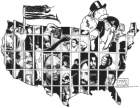At one level, this probably sounds absurd.
A group of faith communities from around the state is revving up a campaign to cut the Wisconsin prison population in half by 2015. That would mean reducing the current inmate population of almost 22,000 down to 11,000.
One initial reaction? You’d let all those convicted criminals out of prison? What about safety? What about justice?
And even if you agree with the concept, do you really think that the renewed control of Wisconsin government by conservative Republicans is the sort of political environment that would be receptive to such an idea?
But there are other questions worth asking as well.
Is the criminal justice system we have now really making our communities safer? Is it really providing justice? Is the correctional system we have now the best of all possible ways to do this?
Consider this: Half of the people behind bars in Wisconsin are there for nonviolent crimes. Half of them have issues with drug and alcohol abuse and/or mental illness. And most of them are going to return to our communities at some point. Life sentences are rare.
If our correctional system is just about punishment and cannot help inmates transform their lives, then we are inviting trouble down the line.
Consider this: We went through a great prison-building boom in our state — and across the nation. The war on drugs caught lots of people in its clutches. The efforts to make sentences longer and to do away with allowing good behavior to reduce a prison sentence has kept the prisons jam-packed.
None of this comes cheaply — and part of the cost has been a diminishment of treatment resources to keep people out of prison on the front end and to help them while serving their terms.
Consider this: Over the past generation, Wisconsin has chosen a very different path than our neighbors in Minnesota. Two states with a lot of similarities in demographics and crime rates, with nearly the same populations — yet in 2010, Wisconsin had 22,000 people in prison and Minnesota had 9,500 people in prison. Wisconsin spent $1.3 billion on its corrections budget in 2009 and Minnesota spent less than half of that — $521 million.
There are lots of differences in criminal justice strategies between the two states that are worth exploring elsewhere, but the main point is that the Wisconsin way is not the only way. And from both a human and a financial standpoint, it is not the best way.
The Rev. Jerry Hancock, a former assistant district attorney and a former assistant attorney general, knows something about the criminal justice system. Now he is an ordained minister at Madison’s First Congregational Church. He leads the Prison Ministry Project and is part of the leadership of the 11X15 campaign of the faith groups.
To solve the crisis in our prisons does not take rocket science, he says. “We need treatment on the front end to keep people out, help on the back end to keep people from going back into prison after release and a way to allow people in prison to earn their way out. If we did all three of those things, we could solve this in three years.”
Well, sure. Except for the politics of it. Not to worry, says Hancock. This is not a partisan problem. It was the policies of both Democrats and Republicans that got us to this point. “This is both a fiscal and a moral crisis that crosses party lines,” he said. “It will take a bipartisan effort to solve the problem.”
One step in that direction will be a rally at Fountain of Life Church, 633 W. Badger Road, Madison, on Sunday, Nov. 18, at 4 p.m. to launch a Madison group called MOSES, the local branch of a statewide network known as WISDOM, an interfaith movement for social justice. The 11X15 campaign is the top issue for the group.
And last week’s election actually offered a few glimmers of political hope. When Colorado and Washington voted to legalize the recreational use of marijuana in their states, the votes represented a shift in public attitudes about the war on drugs. And voters in California eased the three-strikes-and-you’re-out law that has trapped people in prison for unduly long times for relatively minor offenses.
An absurd idea to reduce Wisconsin’s prison population by half? Maybe not. It’s at least worth a serious discussion rather than a glib dismissal.
Phil Haslanger is pastor of Memorial United Church of Christ in Fitchburg. He spent about 35 years as a journalist at The Capital Times before moving on to a career in ministry.
This column originally ran in The Capital Times on Nov. 13, 2012.
Via @ WiscNews

This is so great. The US needs to stop being the #1 incarceration country.
Please help us stop mandatory 25 years incarceration in NJ. Tell NJ politicians this is not acceptble even if you are not from NJ.
http://www.change.org/petitions/families-advocating-intelligent-reform-nj-fair-stop-new-jersey-from-forcing-sexual-abuse-victims-to-testify-in-court#
LikeLike
They should be applauded
LikeLike
Our need to be the World’s Jailer is bankrupting the states and the Federal government. Slowly, people are seeing the writing on the wall, and looking for ways to resolve this intolerable situation.
Great article, Prisonmovement’s Weblog. You guys are the bomb.
LikeLike